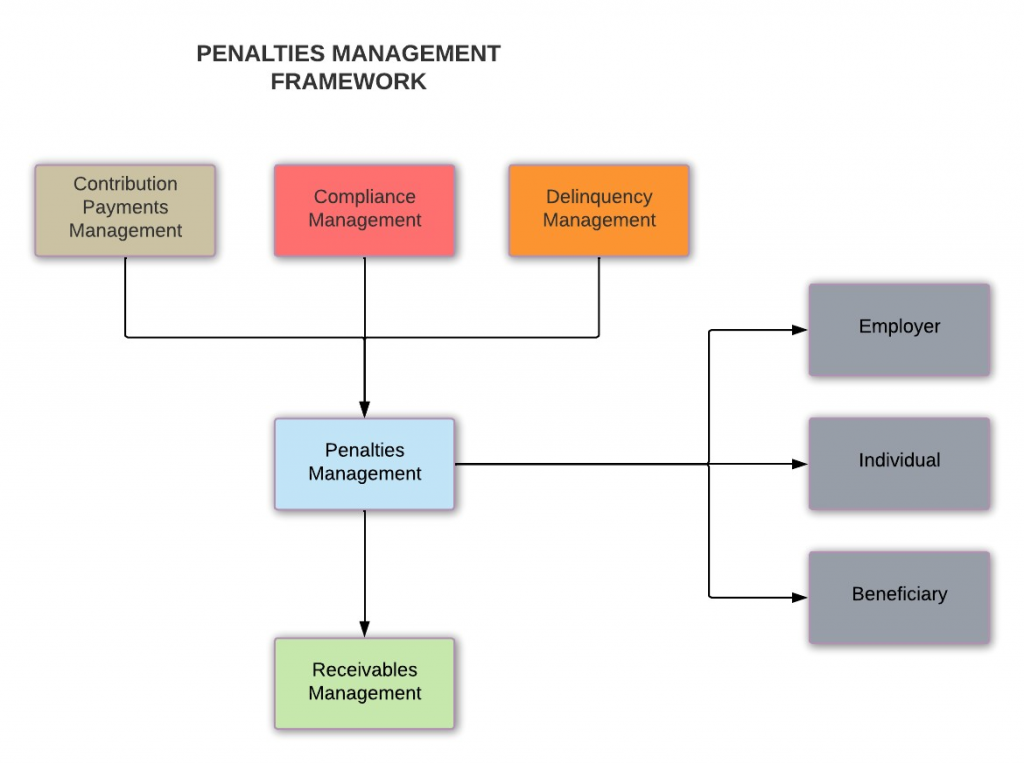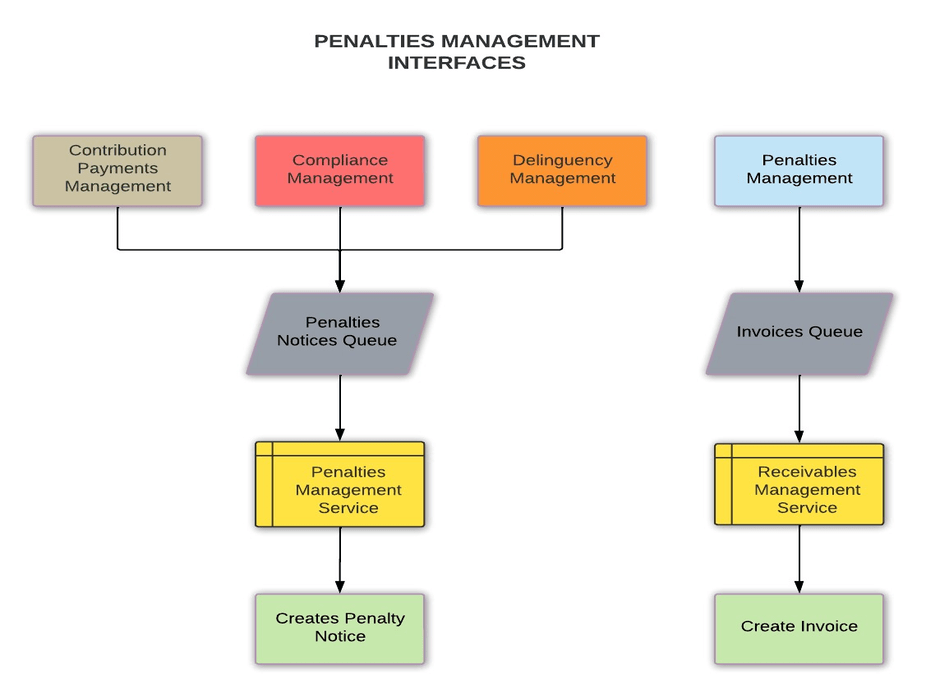Penalties Management ensures compliance with Social Security laws and regulations by enforcing penalties for non-compliance. Penalties can be applied to employers, individuals, and beneficiaries who fail to meet their obligations. These penalties can be monetary, requiring payment of a fine, or non-monetary, resulting in administrative sanctions such as termination of benefits or revocation of a business license. The module automates the issuance, review, approval, and tracking of penalties while integrating seamlessly with compliance, delinquency, and receivables management.
Features and Processes
Penalty Issuance and Types
- Penalties can be monetary (fines) or non-monetary (suspension of benefits, legal restrictions).
- Automatic issuance of penalties through Contribution Filing and Payment, Compliance Management, or Delinquency Management.
- Manual issuance of penalties via the Penalty Notice Form by authorized users.
- Integration with Receivables Management to generate invoices for monetary penalties.
- Configurable penalty calculation methods, including fixed amounts, percentage-based penalties, or interest-based penalties on unpaid amounts.
Penalty Notice Creation and Workflow
- Manual Penalty Issuance: Users create a penalty notice manually for cases requiring special review.
- Automated Penalty Issuance:
- Contribution Filing and Payment: Late filings and unpaid contributions trigger automatic penalties.
- Compliance Management: Compliance audits identify violations, generating penalty notices.
- Delinquency Management: Penalties are imposed for persistent non-compliance with debt repayment agreements.
- Penalty Notice Review and Approval:
- Review process ensures proper assessment before penalty enforcement.
- Multiple approval levels including managers, supervisors, and auditors.
- Notices can be rejected or canceled if incorrectly issued.
Penalty Payment and Receivables Integration
- Approved penalty notices automatically trigger invoice generation in the Receivables Management module.
- Employers and individuals receive notifications and must make payments within the deadline.
- Payments can be tracked through self-service portals and integrated cashier management systems.
- Late payments result in additional penalties based on pre-configured penalty policies.
Penalty Notice Rejection and Cancellation
- Users can reject penalty notices if issued incorrectly.
- Canceled penalties are recorded for auditing purposes.
- A structured review and approval process ensures penalties are only revoked when justified.
Compliance and Delinquency Linkages
- Compliance Module Integration: Audits can lead to penalties based on employer actions or failure to comply with social security laws.
- Delinquency Module Integration: Unpaid debts trigger penalties, with escalations based on repayment performance.
- Contribution Filing and Payment Integration: Late filings automatically incur penalties, added to the employer’s balance.
Penalty Calculation and Application
- Configurable penalty structures:
- Fixed Penalty Amount: Applied regardless of delay duration.
- Function of Unpaid Days: Daily penalty amount multiplied by the delay duration.
- Penalty Percentage on Income: A percentage-based penalty applied to outstanding amounts.
- Interest-Based Penalties: Annual interest rates applied to unpaid contributions.
- Recurring and one-time penalties can be defined based on policy.
- Employers, self-employed individuals, and voluntary contributors can be subjected to different penalty types.
Review, Approval, and Audit Trails
- Every penalty action is logged for auditing.
- Approval workflows define authorized reviewers and approvers for penalty notices.
- Officers assigned to penalties can update, approve, reject, or escalate notices as needed.
- Status tracking ensures transparency from issuance to settlement.
Integration with Other Modules
- Receivables Management: Generates invoices for penalty payments.
- Contribution Management: Applies penalties directly to employer filings.
- Compliance Management: Ensures penalties result from structured audits and investigations.
- Delinquency Management: Links penalties to outstanding debts and payment defaults.
The Penalties Management module automates the enforcement of penalties, ensuring compliance with social security regulations. By integrating with compliance audits, contribution filing, and receivables management, the system streamlines penalty issuance, approval, and tracking. With configurable penalty structures, review workflows, and audit capabilities, this module enhances enforcement and transparency in managing social security penalties.
Payables Management – Detailed Overview with Screenshots
Penalties are a result of entities not complying with the laws and regulations governing the Social Security Services. Penalties can be applied to employers, individuals, and/or beneficiaries who fail to comply with specific laws of the Social Security regulations. A penalty can be either monetary or non-monetary. In the case of a Monetary Penalty, the concerned party will be served with a Penalty Notice explaining the reason(s) for the Penalty and the amount to be paid (Fine) to settle the penalty. In case of a non-monetary penalty, the concerned party will be served with a Penalty Notice, which includes the reason of the penalty and the explanation of the non-monetary penalty, which can include Termination of Benefits, Revocation of a Business License, etc.
Framework
The Penalties Module Framework consists of the processes that may initiate a Penalty Notice as a result of an action within the process, and these processes include the Compliance Management and Delinquency Management. Additionally, the Payment Management Module is interfaced to the Receivables module in case the Penalty is monetary, in this case a trigger is sent to the Receivables Management module to issue an Invoice for the Penalty.
Figure 1: Penalties Management Framework
The entities involved in the Penalties Management process, include Employers, Individuals, and Beneficiaries. The Penalties can be applied to any of these entities.
Creation of Penalty Notice:- There are three ways in which the Penalty Notice can be created: one method is manual and the other two methods are automatic:
- Manual – This is when the user creates a Penalty Notice using the Penalty Notice form. Once the Penalty Notice is manually created and approved, the system will automatically invoke the Penalty Script defined in the Penalty Policy definition of the Penalty Policy selected in the Penalty Notice form.
- Automatic – The Penalty Notice will be automatically invoked through the following modules:
a.Contribution Filing and Payment Module – When the Contribution Payment process is launched, the system will automatically check the delay in the payments and create the Penalty Notice automatically. The user will be alerted that a payment is delayed, and a Penalty Notice will be created and displayed for the Penalty Notice to be reviewed and confirmed. Once the user confirms the Penalty Notice, the system will post the Penalty Notice for review and approval.
b.Compliance Module –As a result of a Compliance Process, such as a Compliance Audit, a Compliance Audit Action can be chosen or recommended to apply a Penalty. Or the choice of Penalty can be chosen as the Legal Action, in which case the system will display the Penalty Policies, and the user will select the desired Penalty Policy. After approval of the Compliance Audit, the system will automatically create the Penalty Notice. The user will be alerted that a Penalty Notice is created, and a Penalty Notice will be created and it will display the Penalty Notice to review and confirm. Once the user confirms the Penalty Notice, the system will post the Penalty Notice for review and approval.
c.Delinquency Module –If the Delinquency Request Action is chosen as “Penalty” by selecting the “Penalty Policy” in the Delinquency Request form, the system will automatically create the Penalty Notice. The user will be alerted that a Penalty Notice is created, and a Penalty Notice will be created and it will display the Penalty Notice to review and confirm. Once the user confirms the Penalty Notice, the system will post the Penalty Notice for review and approval.
Penalty Notice Rejection – Users can Reject a Penalty Notice when reviewing a Penalty Notice form and this Rejection will need to be Reviewed and Approved for it to be final.
Penalty Notice Cancellation – Users can also choose to Cancel a Penalty Notice after it was originally Approved, for example if the circumstances affecting the Penalty Notice have changed.
Review and Approval of Penalty Notice – The Review and Approval is based on the General Setup of the Penalty Management and the Penalty Policy Definition. Depending on the setup, the following will take place:
Figure 2: Penalties Management Interfaces
Penalties Interface – This interface is used to create Penalty Notices by reading the entries in the Penalties Notices Queue. The Penalties Notices Queue is populated by the three modules including Contribution Payment Management, Compliance Management, and Delinquency Management. Once a Penalty-based transaction is approved in any of these modules, the relevant module creates a Penalty Notice Entry in the Penalties Notices Queue. The Penalties Management Service in turn, reads the entries in the Penalties Notices Queue and creates the Penalties Notices. The Penalties Management Service is a background service that runs forever and based on its setup, it picks up the Penalties Notices Queue and creates the Penalties Notices, and marks those entries as processed.
Receivables Interface – This interface is used to create Invoices by reading the entries in the Invoices Queue. The Invoices Queue is populated by the Penalties Management Module. Once a Penalty Notice is approved, the system creates an Entry in the Invoices Queue. The Receivables Management Service in turn, reads the entries in the Invoices Queue and creates the Invoices. The Receivables Management Service is a background service that runs forever and based on its setup, it picks up the Invoices Queue and creates the Invoices, and marks those entries as processed.



